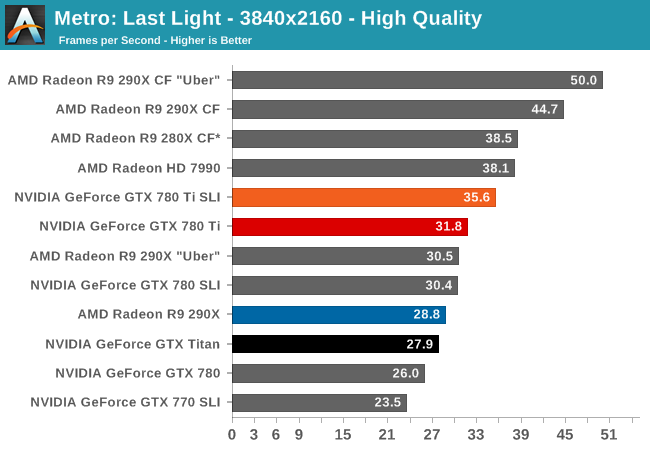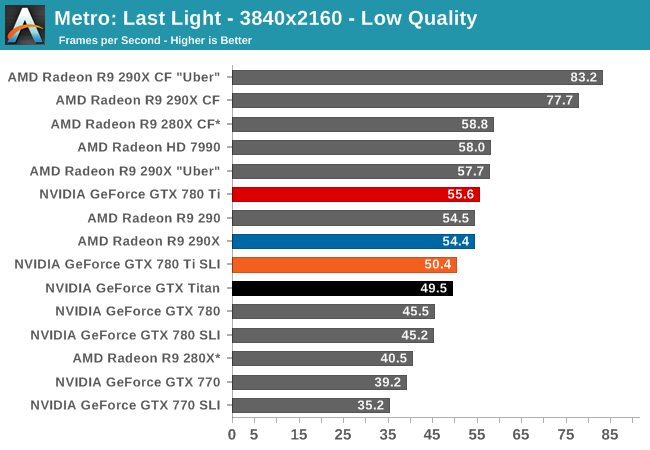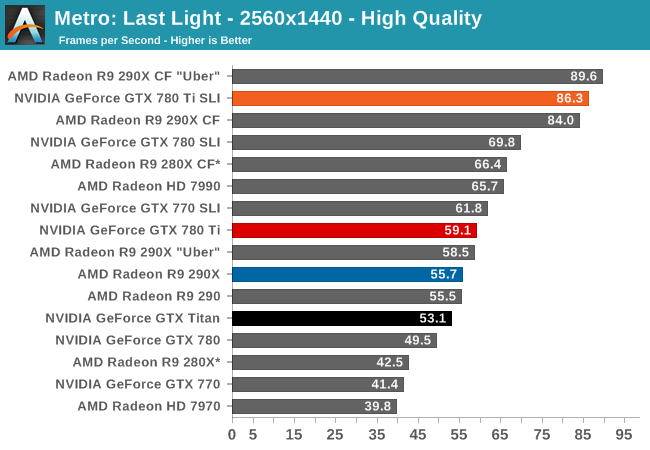The NVIDIA GeForce GTX 780 Ti Review
by Ryan Smith on November 7, 2013 9:01 AM ESTMetro: Last Light
As always, kicking off our look at performance is 4A Games’ latest entry in their Metro series of subterranean shooters, Metro: Last Light. The original Metro: 2033 was a graphically punishing game for its time and Metro: Last Light is in its own right too. On the other hand it scales well with resolution and quality settings, so it’s still playable on lower end hardware.



For the bulk of our analysis we’re going to be focusing on our 2560x1440 results, as monitors at this resolution will be what we expect a single GTX 780 Ti to be primarily used with. A single card does have the necessary horsepower to drive a 4K monitor on its own, but only at lower quality settings. Even as powerful as GTX 780 Ti is, a pair of them will be needed to get good framerates out of most games if using 4K at high quality settings.
Looking at our Metro: Last Light results then, it’s the start of what’s going to be a fairly consistent streak for the GTX 780 Ti. Though it doesn’t improve on GTX Titan or GTX 780’s gaming performance by leaps and bounds, the additional SMX and increased clockspeeds means that it has little trouble pulling away from those cards and from AMD’s 290 series. As a result the GTX 780 Ti beats the GTX Titan by 11%, GTX 780 by 19%, and though it’s closer than normal, the lead over the 290X stands at 6%.
To that end in Metro it leads the pack of single-GPU cards, though it does come up just short of being able to average 60 frames per second at 2560. Anything over 60fps will require multiple GPUs; and even then GTX 780 Ti is fast enough that sometimes even a pair of GPUs (GTX 770 SLI) isn’t going to be appreciably faster.
Meanwhile looking at GTX 780 Ti SLI performance, the SLI setup tops the charts at 2560 for everything short of the 290X in uber mode, though in this case (like most cases) two high-end GPUs is on the verge of being overkill even at 2560. Otherwise looking at 4K, NVIDIA’s poor 4K scaling on Metro once again makes itself present here, with NVIDIA’s performance only minimally benefitting from the second card. In the case of Metro at 4K, the 290X CF is going to be by far the faster option.










302 Comments
View All Comments
Ryan Smith - Thursday, November 7, 2013 - link
Very limited time. 290 launched on Tuesday, 780 Ti launched on Thursday. If I had a couple more days I would have used the time to collect data from some older cards.undeadpolice - Thursday, November 7, 2013 - link
Thanks Anantech, I was worry that I make the wrong choice by buying two weaker R9 290x as money is not issue for but performance is, with all the Gtx780ti hypeAt least I was preparing for a regret it but it turns to be a present surprise!
GeorgeH - Thursday, November 7, 2013 - link
What does the asterisk next to the 280X benchmarks signify?Ryan Smith - Thursday, November 7, 2013 - link
Non-reference. We don't have a reference 280X, and for 280X CF it's an oddball combination of an XFX card and an underclocked Asus card.ludikraut - Thursday, November 7, 2013 - link
Ryan, how are you coming up with "This [780ti performance advantage] will break down to being 11% faster than Radeon R9 290X, 9% faster than GTX Titan, and a full 20% faster than the original GTX 780 that it formally replaces"? I looked through the test results again, and if I focus on the 4K results, what really strikes me is how close the R9 290 stays on the heels of the 780ti (often within 1-2 FPS). Heck in some cases the $400 R9 290 is ahead of the $700 780ti. Also, why no results for dual/triple monitor setups?l8r)
Yojimbo - Thursday, November 7, 2013 - link
Well that's good. Buy a $400 card, $800 on monitors or whatever, and run everything at a high resolution and extremely low quality settings. Either that or suffer through 30 fps average frame rates and minimum frame rates of god knows.Ryan Smith - Thursday, November 7, 2013 - link
Our focus is on 2560x1440, and that's where we draw our primary conclusions from. As we've mentioned in the past few weeks in other reviews (290X, etc), we don't consider 4K to be viable for a single card setup right now. You have to make some very significant quality compromises in most cases, which are far more detrimental than the extra resolution is beneficial. 4K gaming really requires a multi-GPU setup right now, which is why we focus on 4K when discussing said multi-GPU setups.As for multi-monitor setups, the use of a 4K tiled monitor generally makes those redundant. It tests the same technology, and does so at an even higher resolution than 3x1080p. Since we don't have the time to do 2560 and 4K and multi-monitor, we've opted for the first two on the basis listed above.
NewCardNeeded - Thursday, November 7, 2013 - link
Wow, after reading this review it's become clear what graphics card I'm now going to buy.An R9 290 with 3rd party cooler :-)
Da W - Thursday, November 7, 2013 - link
In the sake of fareness, ill add an unbiased review. Since AMD cards scale better than Nvidia at 4K, and that "uber" mode is noisy but still is the mode where the card really runs at full speed (NOT overclocked), i think its grossly unfair to only cite 1400p gaming, taking only 290X non-"uber" numbers and call Nvidia a winner.So for 4 k gaming, where a tie means 1or2 FPS difference or that the 780ti sits between the 290X uber and non-uber mode, we see:
-Metro: tie
-CoH2: AMD
-Bioshock: Nvidia
-Battlefield 3: tie (battle field 4 will be a win for AMD but we don't have that here)
-Crysis 3: Nvidia
-Crysis: Tie
-TW Rome2: Nvidia
-Hitman: AMD
-Grid 2: Tie
That's 2 AMD wins, 3 Nvidia wins and 4 ties at 4K, which is also a good proxy for eyefinity/surround setups.
AMD is louder and Nvidia is 200$ more. You essentially pay 200$ for a cooler.
Case closed.
Kutark - Friday, November 8, 2013 - link
nobody cares about 4k. I honestly don't even know why people bother to benchmark. Like the author said, 4k is only viable in multi (high end) GPU setups. So we're talking 800+ dollars just for video cards, the only 4k monitor out right now is $3800, has a 30hz refresh rate and fucking terrible input lag. NOBODY IS GAMING AT 4K. If we were having this discussion a year from now things might be a *little* different. But we're not, we're having it now. So, i state once again, nobody except AMD fanbois trying to stroke their proverbial cocks gives 2 shits about how these cards scale at 4k resolution.